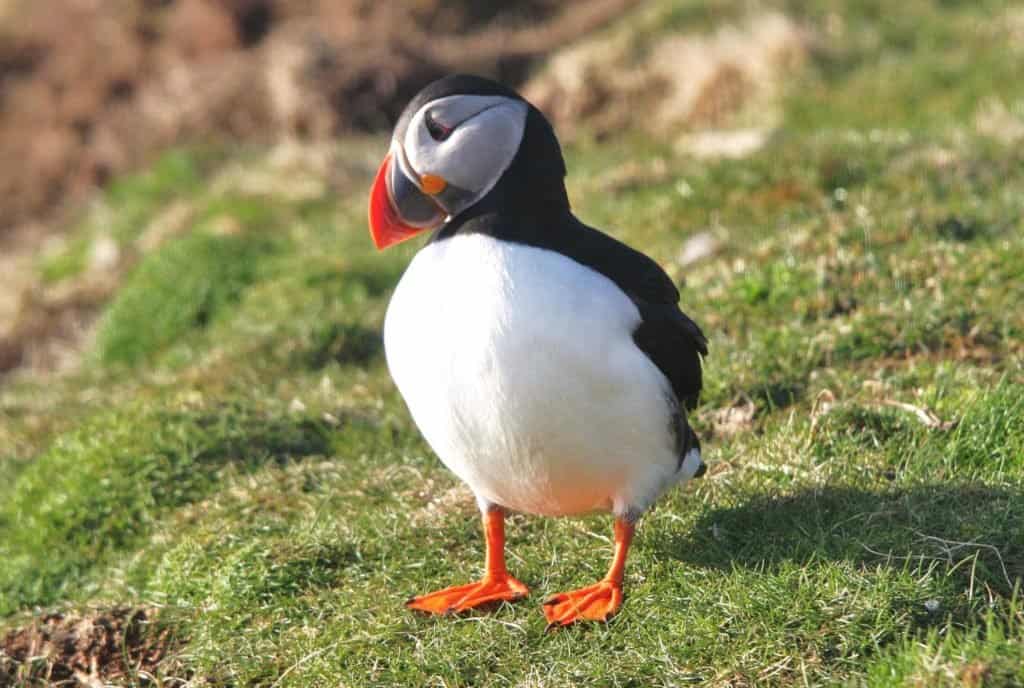Over time, as animals evolved, they have physically adapted to better survive in their environments. Some animals developed webbed feet to help them find food or navigate their surroundings. Webbed feet enable these animals to swim, walk, and climb more efficiently. For example, webbed feet help quickly propel an animal through water to evade predators, or aid in hunting food, giving animals that live near bodies of water a great advantage. In addition, they prevent sinking in sandy or muddy environments. Some animals have fully webbed feet, and others partially, as it all depends on the animal’s conditions. In this article, we will talk about animals with webbed feet from birds to mammals.
Birds
Albatross (Phoebastria irrorate)

Their keen sense of smell can detect food in the water from 12 miles away.
©Andrew M. Allport/Shutterstock.com
Albatross use their webbed feet for aviation purposes, such as during liftoff, when landing, to slow down, and when they want to land on water. Of the 22 species, they inhabit New Zealand, Australia, and from Antarctica to South America. They are one of the largest flying birds sporting a 12-foot wingspan! In particular, the Waved Albatross (Phoebastria irrorate) is among the most graceful species. They are beautiful when in flight, staying aloft without flapping their wings. In addition, they make loyal mates that partner for life. These birds feed on crustaceans and fish.
Antarctic Petrels (Thalassoica Antarctica)
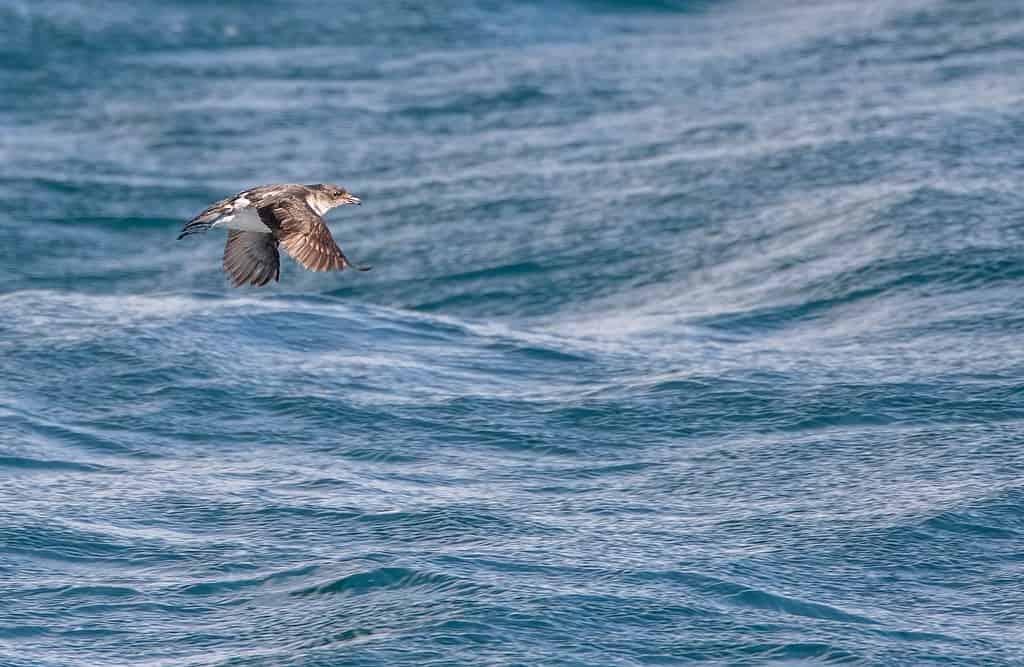
The Antarctic Petrels nest on rocky cliffs.
©Traveller MG/Shutterstock.com
Four webbed toes enable these medium-sized sea birds to swim well. Native to Antarctica, particularly the Weddell and Ross Seas, they dive from the air as well as surfaces. They have a 39–43-inch wingspan and weigh around 23 ounces. Their favorite foods include fish, krill, and squid.
Avocets (Recurvirostra)
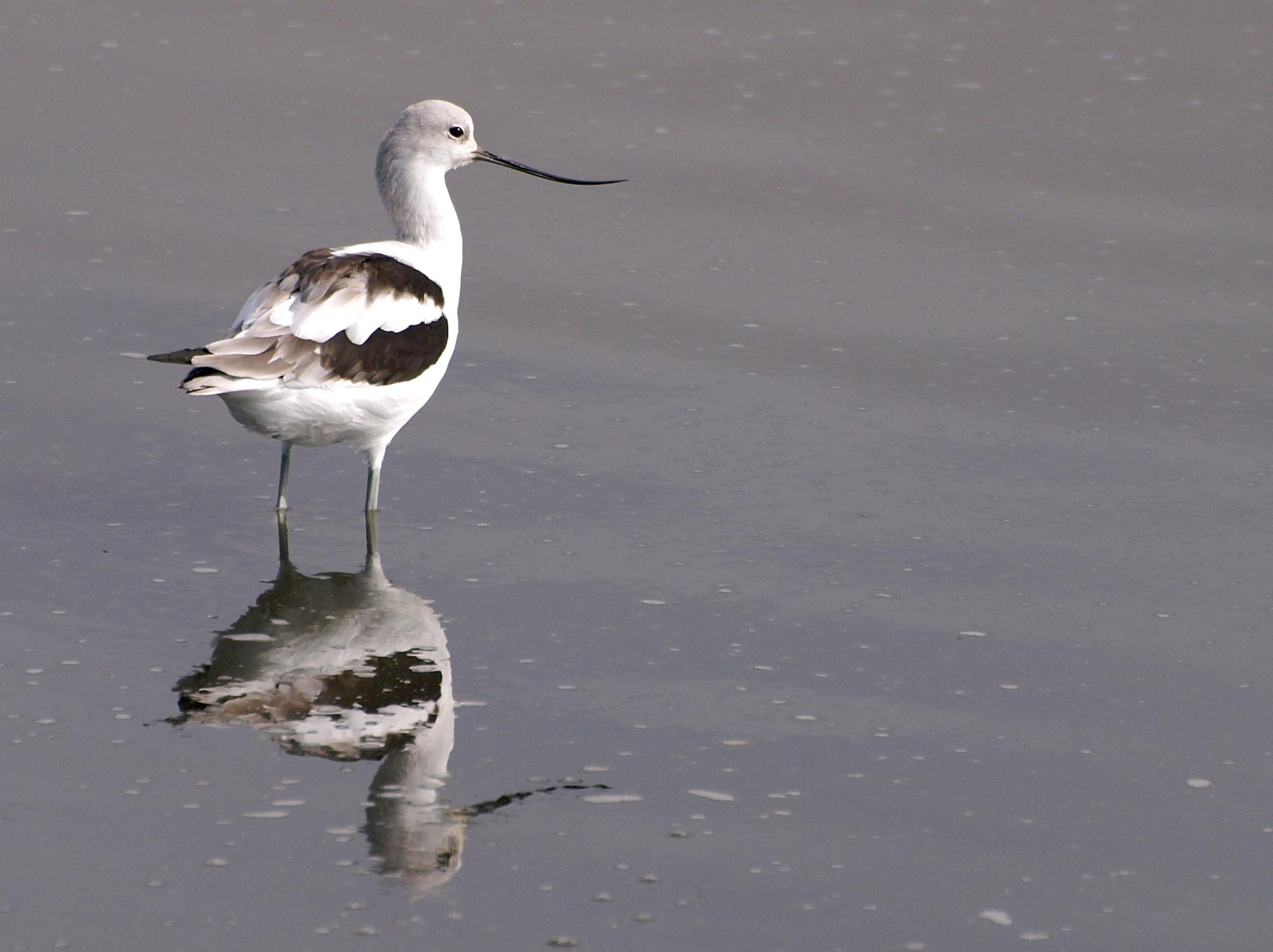
The plumage on an avocet’s head and neck changes with the seasons.
©Ingrid Taylar from San Francisco Bay Area – California, USA, CC BY 2.0, via Wikimedia Commons – License
Webbed feet aid the avocet in swimming. Their name is Latin for “curved backward” describing their particularly curved bills. This wader possesses long legs, and so they spend much of their time in shallow waters hunting for food. Consisting of four species, they reside in South and North America, Europe, and Asia. They enjoy eating small creatures, fish larvae, and aquatic insects.
Blue-Footed Boobies (Sula nebouxii)
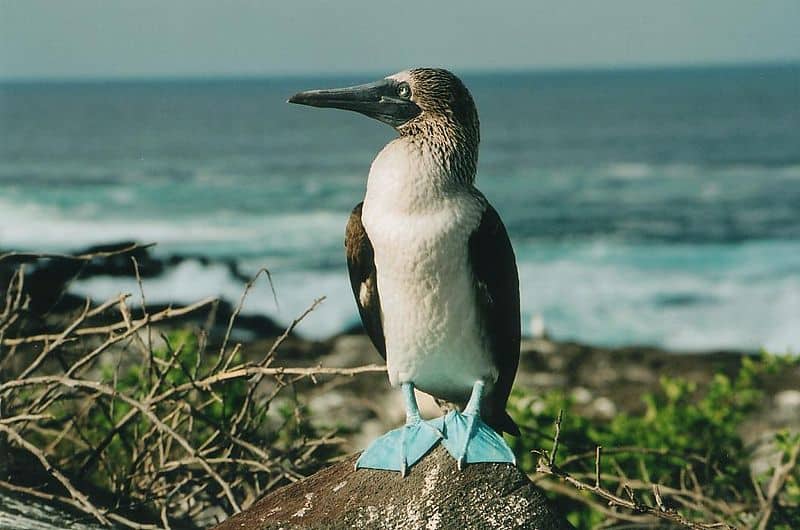
Male blue-footed boobies with the bluest feet have a higher chance of mating.
©Rileypie – Public Domain
Undoubtedly, the bright blue webbed feet and facial skin give this bird their colorful name. The term “booby” comes from the Spanish word “bubi,” meaning “stupid fellow” due to their clumsiness when walking on land. They use their webbed feet to aid in swimming, attract females, and incubate their eggs. They are native to subtropical and tropical areas of the Pacific Ocean and love to eat squid, flying, and small fish.
Cormorants (Phalacrocoracidae)
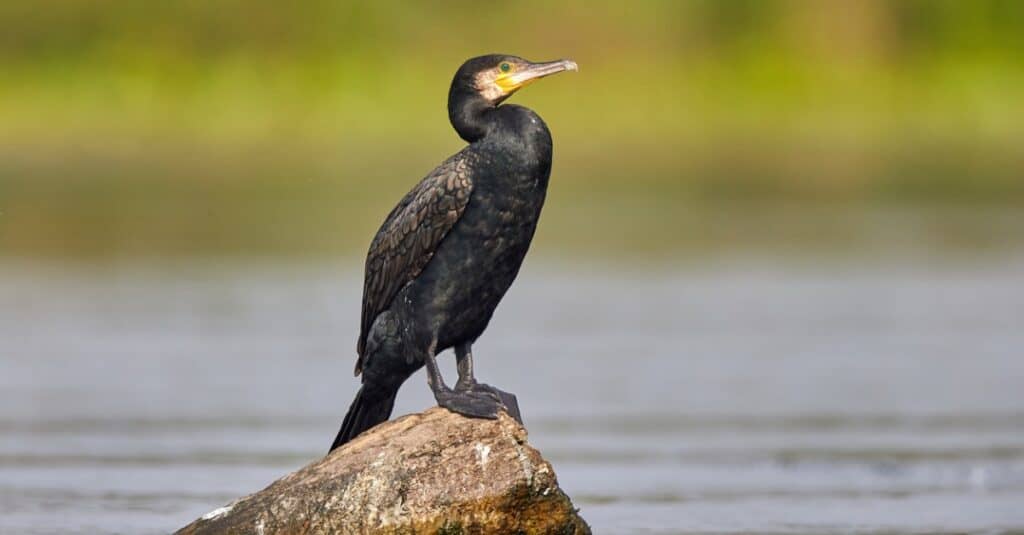
The cormorant’s wings are relatively short due to their need to swim.
©iStock.com/Richard Constantinoff
Great divers, these birds use their webbed feet to propel them through water. Indeed, they are excellent divers and can reach depths of 150 feet. Using their wings as rudders, they speed effortlessly through water. As a result, these large dark-feathered birds are certainly aerodynamic. They are native to most areas of the world except for the Central Pacific Islands. They feed specifically on fish in lakes, rivers, and sea coasts.
Crab Plovers (Dromas ardeola)
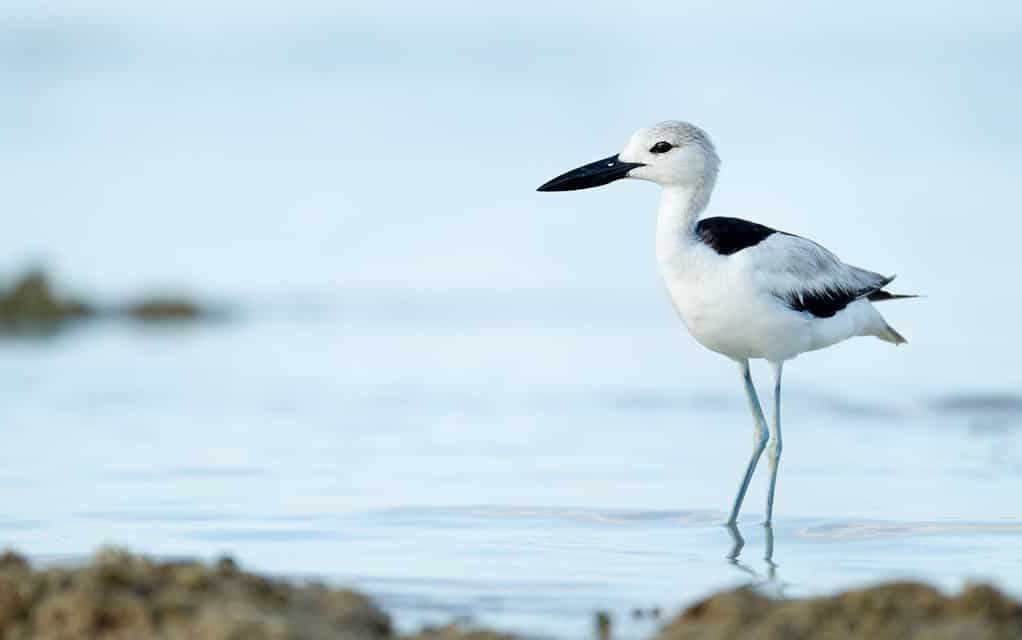
The crab plover builds their nests in burrows in sandy banks.
©Thipwan/Shutterstock.com
This wading bird has partially webbed feet, useful on marshland, and a long gull-like bill perfect for eating crustaceans, small mollusks, marine worms, and crabs. They nest in colonies as large as 1,500 pairs where they lay one, maybe two, eggs on the coasts and islands of the Indian Ocean.
Ducks (Anatidae)

Ducks have highly waterproof feathers.
©Ian Kirk from Broadstone, Dorset, UK / CC BY 2.0, via Wikimedia Commons – License
Related to geese and swans, ducks are made for swimming! They have palmate feet, which are the most common type of webbed feet. The circulatory system in their legs and feet is specifically designed to allow them to swim in cold water where they spend much of their time looking for food. Additionally, hollow bones and air sacs lighten their weight to stabilize them while they float half-submerged. Not only are they aquatic, they walk on land and fly short distances. Favorite foods include crustaceans, amphibians, insects, worms, seeds, and pondweed they find in rivers, wetlands, lakes, and ponds.
Flamingos (Phoenicopterus ruber)

Flamingo nests are constructed out of mud.
©Jckfreder/Shutterstock.com
Identifiable by their pink color, skinny legs, and long necks, this wader’s webbed feet allow them to swim efficiently and support them while walking on soft mud. Most of their time is spent in water, often standing on one leg. They typically stand about 43 inches tall with a 5-foot wingspan. Native to Central, South, and North America, they also reside in Louisiana and southern Florida, especially the Keys. When it is mealtime, they place their head in the water upside-down with their bill pointing at their feet. They feed on fish, mollusks, shrimp, crustaceans, and algae.
Geese (Anatidae)
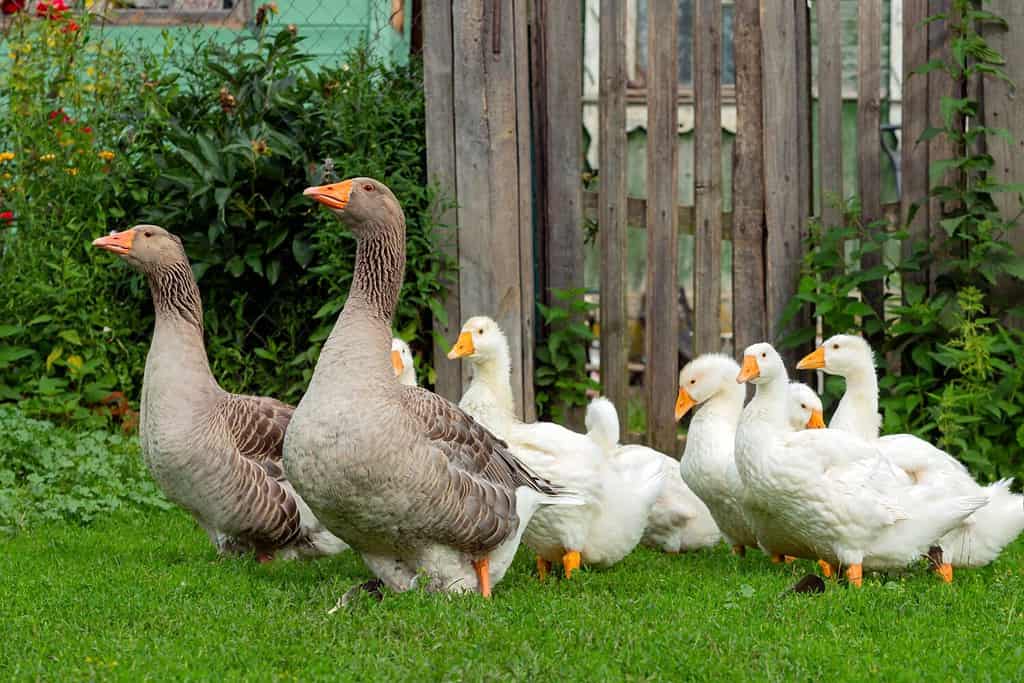
Geese are known for their stunning V-shaped flight formation.
©Kanyshev Andrey/Shutterstock.com
Like ducks, geese possess palmate feet with three webbed toes facing forward and one disconnected from the front pointing back. Their feet act as flippers, and so they pull water back with their feet spread to allow for quick travel. Preferring freshwater environments, they feed on grasses, leaves, and roots. Likewise, most of the several species of geese reside in North America, Europe, and Asia, primarily for temperate or Arctic conditions.
Loons (Gavia)
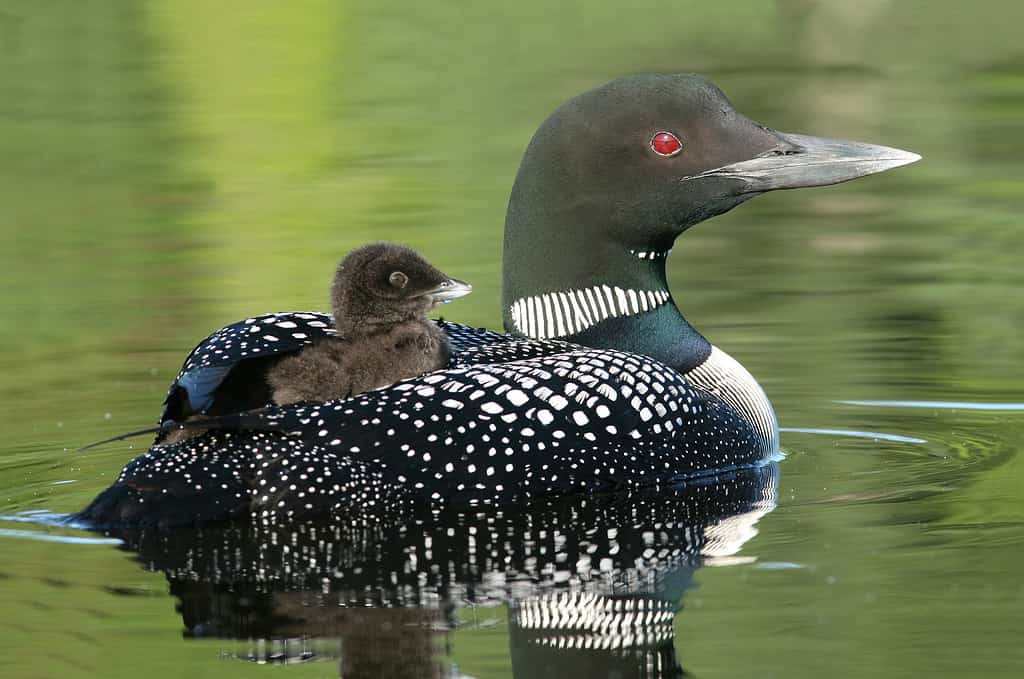
Their legs are placed far back on their bodies so that they swim more efficiently.
©BRIAN LASENBY/iStock via Getty Images
Powerful webbed feet enable the loon to dive, swim fast, and move through water efficiently. In fact, they can stay underwater for about 5 minutes. They are native to Iceland, Greenland, the Northern United States, and Canada. They enjoy eating aquatic animals, including shrimp, crayfish, and fish.
Pelicans (Pelecanus)
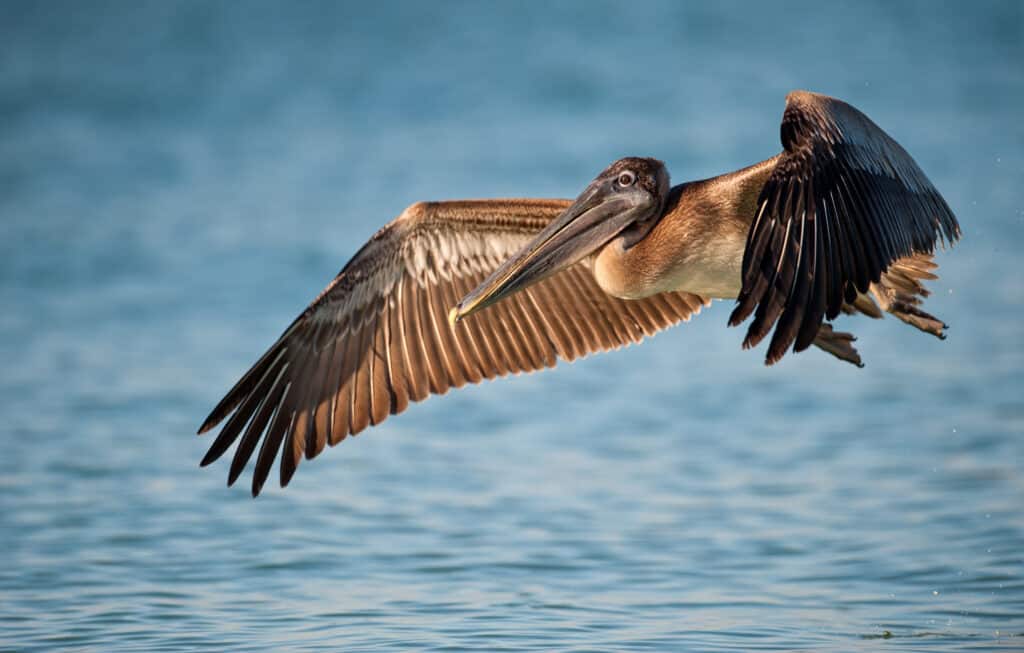
The
pelican
has been here for over 30 million years.
©Nagel Photography/Shutterstock.com
Pelicans are hard to miss with their long beak and large throat pouch, used to catch prey and drain water before ingesting. Specifically, they throw their heads back after a catch and swallow their food whole. Unlike ducks, all four of their toes are webbed, which is called totipalmate feet. When on land, they appear awkward. However, in the water, they show their swimming prowess, and in the air, they soar in graceful formations. Their long wingspan, which can span 10 feet across, enables them to fly for 24 hours without stopping. Additionally, they can reach speeds of 35 miles per hour!
Much of their time is spent fishing in cooperative groups, corralling fish for easy scooping. For instance, they glide across the water using a “ground effect,” reducing drag and saving energy. They feed mostly on fish but occasionally eat small reptiles, crustaceans, and other birds on the Pacific, Atlantic, and Gulf coasts.
Penguins (Spheniscidae)
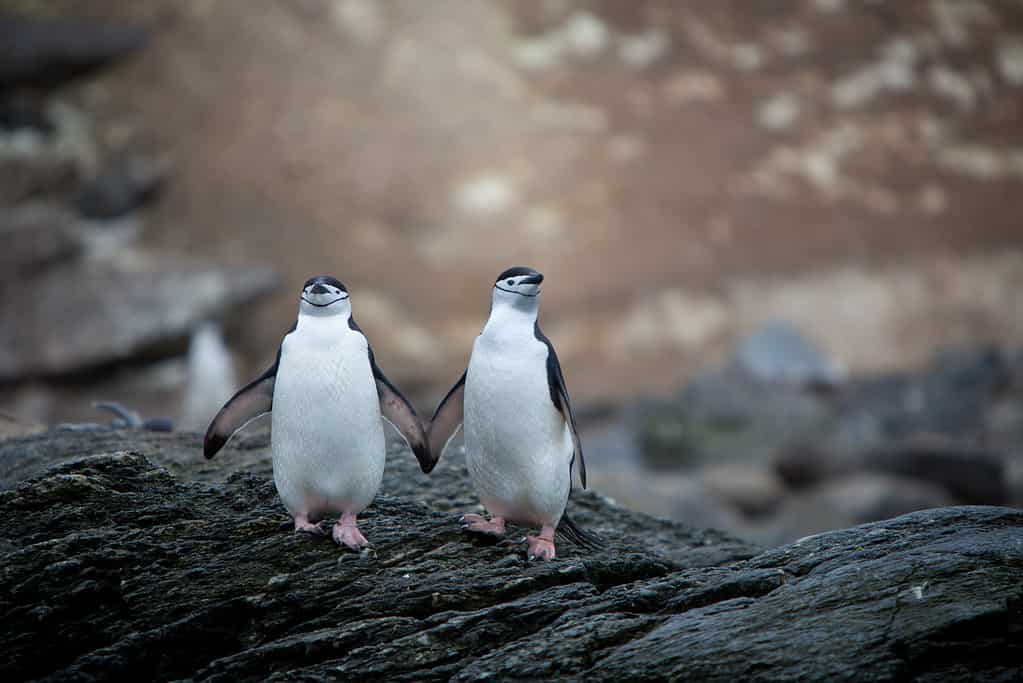
Penguins can slide on their bellies when traveling over ice and snow.
©Chris Venne/Shutterstock.com
Unlike most other birds, penguins are flightless. They spend about 75 percent of their time in the water, with the rest spent on land when molting or breeding. They are also skilled divers. In fact, they can hold their breath for up to 20 minutes. Their webbed feet, streamlined body, and strong flippers allow them to travel at speeds of 15-25 miles per hour! Their favorite foods are squid, fish, and krill. They live in colonies in Australia, South America, New Zealand, Africa, and Antarctica.
Puffins (Fratercula)
Exceptional swimmers and divers, the puffin uses their webbed feet as rudders to dive as deep as 200 feet in the water! They are also incredible flyers, able to flap their wings 400 times a minute. Additionally, their brightly colored beaks change color with the seasons. They inhabit the North Pacific and the North Atlantic and like to eat sand eels, herring, and small fish. In fact, they can grasp 10 to 12 fish at a time due to their spiny palates and rough tongues.
Seagulls (Larus dominicanus)

Seagulls can fly after only five to six weeks after hatching.
©iStock.com/Evgenyi_Eg
With fully webbed feet, seagulls are excellent swimmers. Additionally, these cunning birds use their webbed feet to trick earthworms into coming out by stomping on the ground after a rain! They can dive as deep as 40 feet when hunting. Coastal areas including South and North America, Europe, the Caribbean, Australia, and Antarctica are home to them where they feed on rodents, reptiles, and amphibians.
Trumpeter Swans (Cygnus buccinator)

Trumpeter swans are named for their deep trumpeting call.
©iStock.com/Zeke1
As a member of the duck family, the trumpeter swan possesses snow-white plumage with webbed feet, making them fast and strong swimmers and using them to create currents as they pump water. In addition, this heavy bird utilizes their webbed feet to help launch their heavy body when taking flight, pull plants from the water to eat, and incubate their eggs! They weigh 21-30 pounds, lay eggs up to 5 inches in length, and are native to North American ponds, large rivers, and lakes.
Reptiles
Alligators (Alligator mississippiensis)
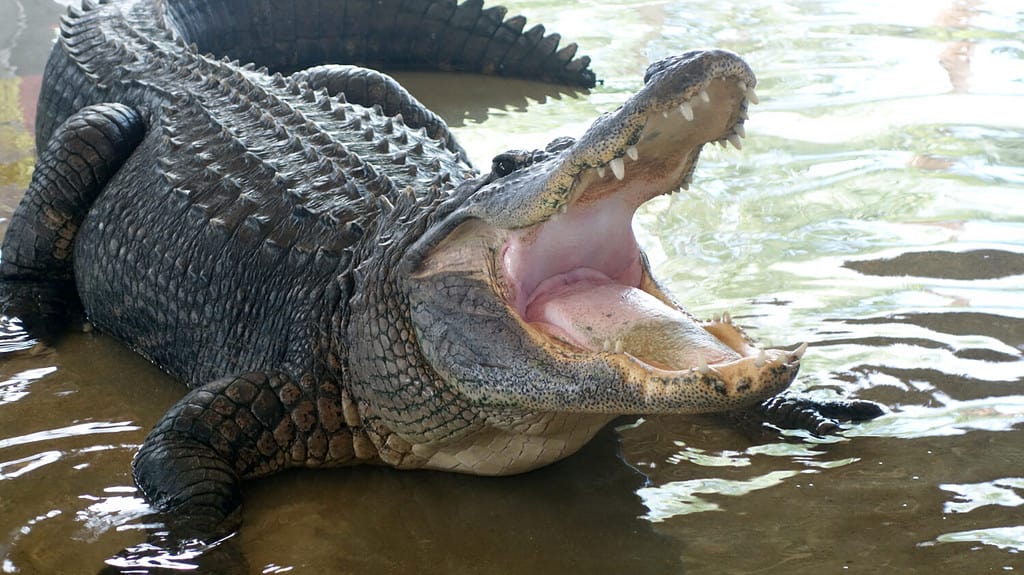
An alligator’s teeth can grow back, and they can go through 3,000 teeth in their lifetime.
©Ernie Hounshell/Shutterstock.com
This large reptile’s front feet have two webbed toes, and their hind feet are fully webbed to enable them to propel through water. In fact, they can travel at a speed of 20 miles per hour, and they spend most of their time swimming, floating, or submerged. An alligator can live 30-50 years, and average in size from 8-12 feet depending on the gender. Specifically native to the Southeastern United States, they like to eat birds, small mammals, turtles, snakes, and fish.
Crocodiles (Crocodylidae)

Crocodiles sleep about 17 hours a day.
©StuPorts/iStock / Getty Images Plus via Getty Images
Semi-aquatic, these large creatures live in the tropics of Central America, south of the Sahara, Madagascar, and Southeast Asia. Their webbed feet aid in navigating slippery surfaces and walking on muddy banks. In addition, they use their tails to swim fast, reaching speeds of 15-18 miles per hour. Their large bodies are covered in waterproof scales to protect them from predators and dryness. They enjoy eating deer, zebra, fish, reptiles, and birds in marshes, lakes, mangrove swamps, and rivers.
Iguanas (Iguana iguana)

Iguanas can detach their tail if need be and grow another.
©Holly S Cannon/Shutterstock.com
These herbivorous lizards use their big webbed feet and powerful tails to propel them through water. They live in lowlands, forests, swamps, and deserts of the Caribbean, South and Central America, and Mexico. When well cared for, they can live for more than 20 years and an average of 12-15 years in the wild.
Amphibians
Axolotls (Ambystoma mexicanum)

Axolotls can regenerate nearly all body parts, including the brain.
©axolotlowner/Shutterstock.com
Known as the “Mexican Walking Fish,” they are a member of the salamander family found in Mexico’s canals, lakes, and waterways. They have developed lungs that allow them to breathe oxygen when on the water’s surface, but mostly use their gills, as they spend most of their time in water. Also, they have underdeveloped webbed feet allowing them to swim underwater. They feed on brine shrimp, insects, worms, and small fish.
American Bullfrogs (Lithobates catesbeiana)
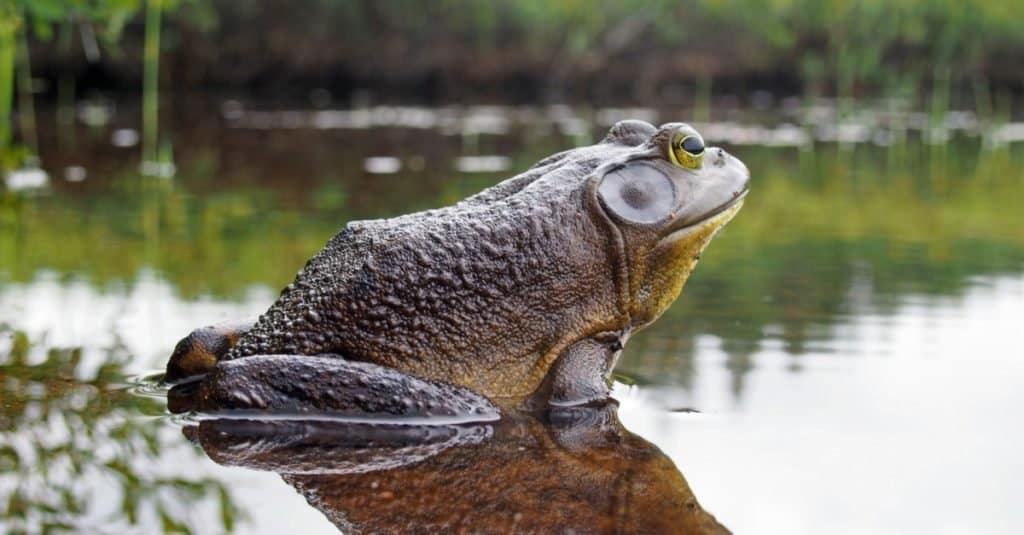
Bullfrogs can jump distances of about 10 times their body length.
©Christian Ouellet/Shutterstock.com
These excellent swimmers possess long and powerful hind legs with webbed feet. In fact, their front toes and the fourth digit of their back toes are not webbed. They are 3-6 inches in length, making them the largest frog in North America. Bullfrogs can be found in swamps, rivers, marshes, lakes, and ponds, where they enjoy eating crustaceans, tadpoles, frogs, fish eggs, snakes, and worms. In addition, they are cannibals that have been known to eat their own kind.
Common Frogs (Rana temporaria)
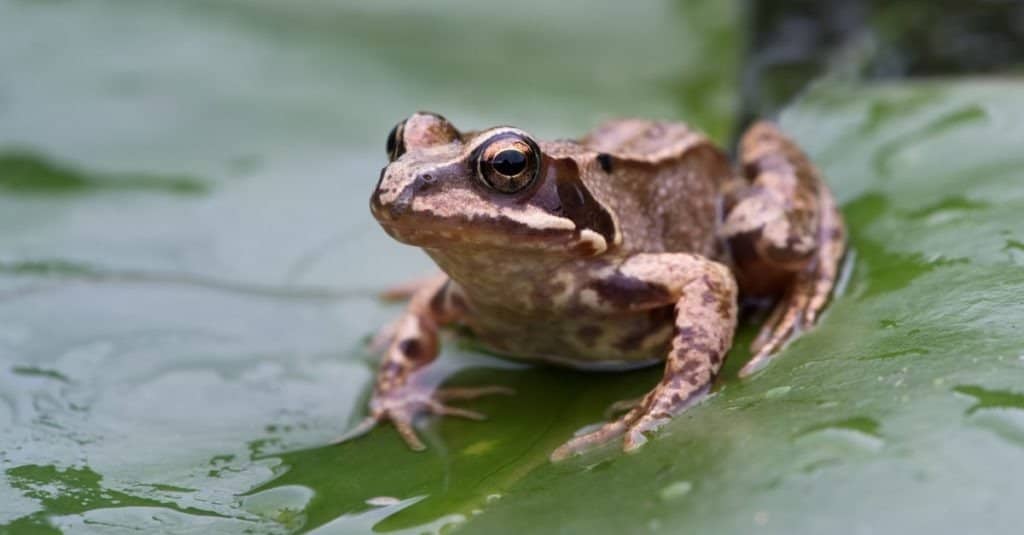
A frog’s bulging eyes enable them to see things in front, on the sides, and partly behind them.
©davemhuntphotography/Shutterstock.com
The common frog only has webbed feet on their short hind legs, while some frogs have both front and hind webbed feet. Webbing is useful in jumping, which comes in handy when escaping predators! They are native to Britain and feed on snails, slugs, and insects. In fact, some of the larger species will eat birds and reptiles.
Natterjack Toads (Epidalea calamita)
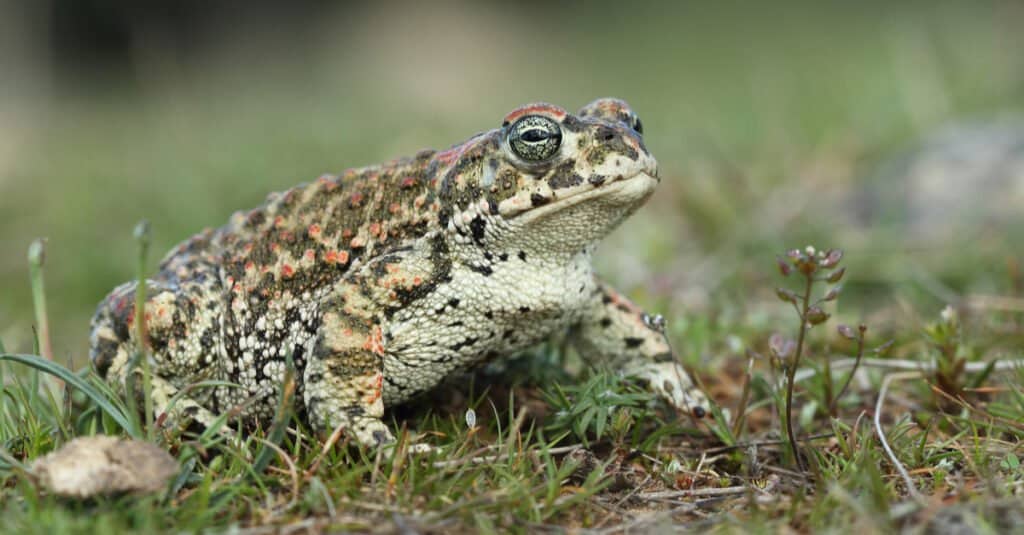
Toads spend more time on land than in the water.
©Hector Ruiz Villar/Shutterstock.com
This noisy toad has short limbs, which end in partially webbed feet. As a result, they tend to run as opposed to hopping like other frogs and are not very good swimmers. They are the only species of toad native to Ireland and are found on about 60 sites in Britain, where they enjoy a meal of beetles, spiders, worms, woodlice, invertebrates, and aquatic plants.
Turtles (Testudines)

Turtles wear their bones on the outside for protection.
©Dennis Diehl/Shutterstock.com
One of the oldest reptiles is the turtle, the earliest species having lived 250 million years ago! Their webbed feet aid them in swimming, and so they spend most of their time in the water. A bony cartilage developed from their ribs protects their body, consisting of the top shell, the carapace, and the bottom shell, the plastron. Scales, known as scutes, cover their shells and are made of keratin, the protein that fingernails are made from. There are about 300 species of turtles and are found in estuaries, bays, and lagoons in South Asia and southeastern North America, feeding on fruits, vegetables, small birds, crabs, and shrimp.
Mammals
Capybaras (Hydrochoerus hydrochaeris)
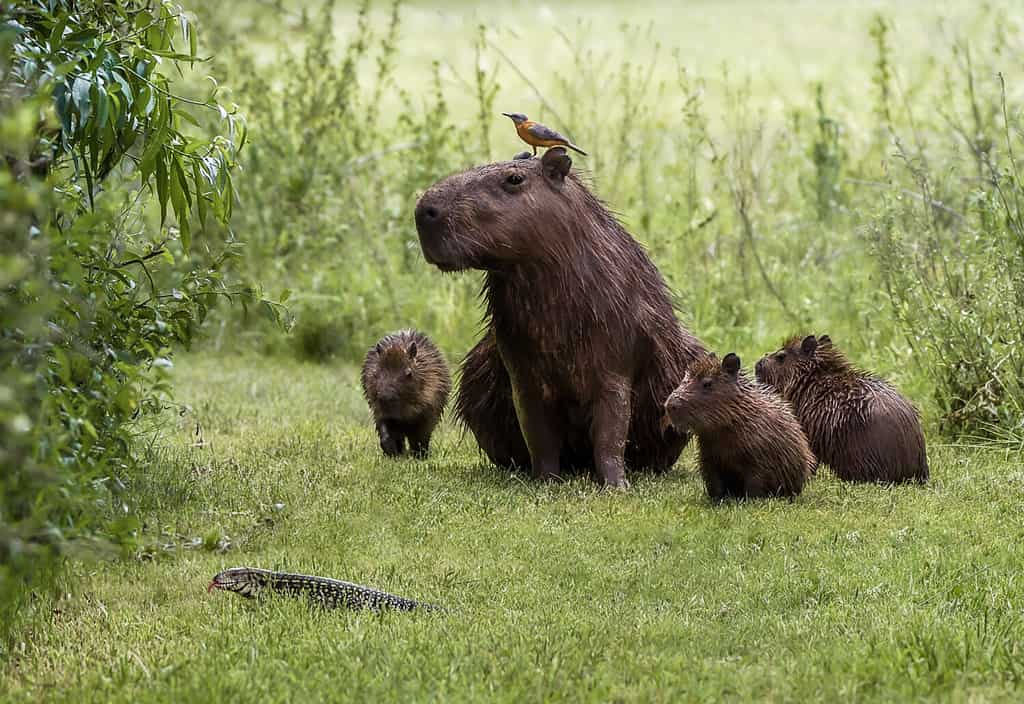
Capybara
are morning feeders, resting in the afternoons.
©Marcel_Strelow/Shutterstock.com
This large rodent from Central and South America is semi-aquatic. Their partially webbed feet, featuring four toes on the front and three on the back, aid in swimming and walking on muddy ground. They also reside in Florida in the United States. They weigh from 75-150 pounds and measure 1-4 feet long. Capybara can also hold their breath for 5 minutes underwater. They use their long, sharp teeth to graze on water plants and grass. In fact, they can eat 6-8 pounds of grass a day! During dry seasons, they enjoy squash, melon, grains, and reeds.
Eastern Moles (Scopus aquaticus)

Moles resemble mice and rats but they are not rodents.
©Liz Weber/Shutterstock.com
Spending nearly their whole life underground, they use their large, spade-shaped front webbed feet for digging! Indeed, they have been known to dig up to six miles an hour. They are around 6 inches in length with grey fur, a pointed nose, and poor eyesight. Native to Mexico, the United States, and Canada, they like to eat larvae, insects, and earthworms in meadows, open woodlands, fields, and pastures.
Fishing Cats (Prionailurus viverrinus)
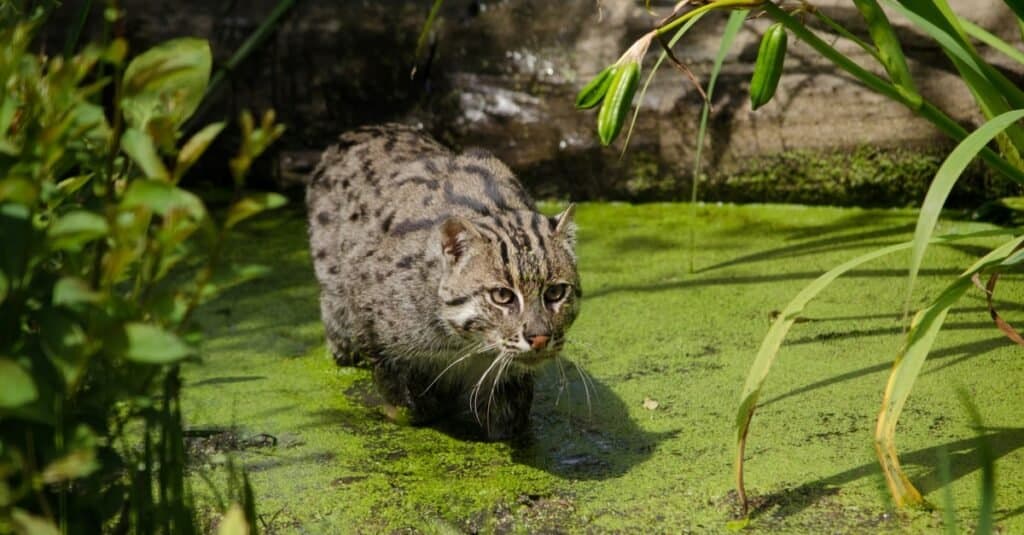
The fishing cat stands out among other types of wild cats as a strong swimmer.
©Gemma Simpson/Shutterstock.com
This wild cat possesses webbed feet, making them skillful swimmers, and they love the water! Their double coat and rounded head are adapted for aquatic life. They are medium-sized, larger than domestic cats, with brownish-grey coats and dark spots. Native to wetlands, mangroves, and swamps in South and Southeast Asia, they like to eat crayfish, frogs, crabs, and fish.
Hose’s Palm Civets (Diplogale hosei)
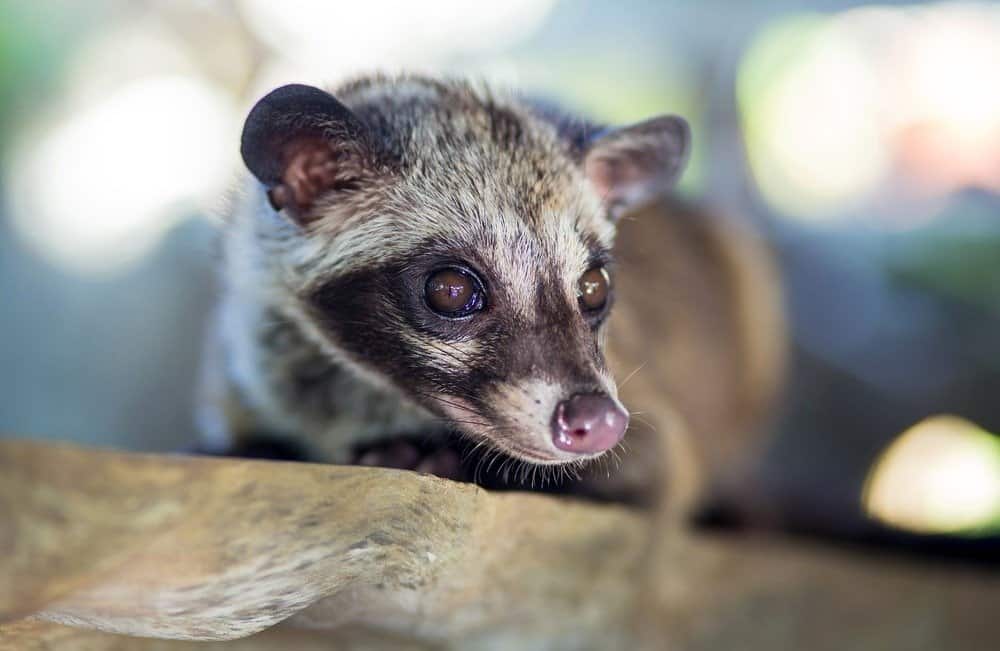
The civet produces a musk, which is highly valued as a stabilizing agent and fragrance for perfume.
©trubavin/Shutterstock.com
Like a domestic cat, the palm civet has partially webbed feet which aids in navigating hunting grounds. Native to the mossy forests of Brunei and Borneo, they are nocturnal ground dwellers. Of little-known information, their diet is thought to include shrimps, crabs, frogs, insects, and fish.
Minks (Neovison vision)
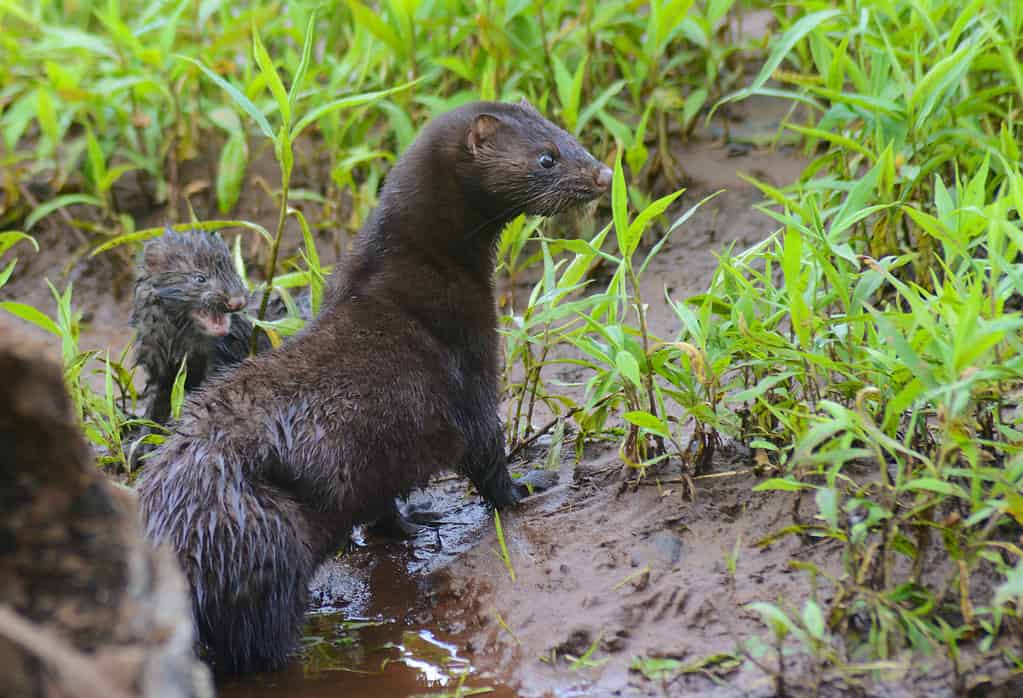
Mink dig their burrows in the banks of streams, lakes, and rivers.
©Betty4240/iStock via Getty Images
This semi-aquatic animal has partially webbed feet that enable them to swim, even underwater. They also help with walking on muddy banks. Their fur retains heat and is waterproof. They are native to North America, Canada, and Newfoundland, where they enjoy eating small animals, clams, crabs, insects, bird eggs, birds, and fish.
Muskrats (Ondatra zibethicus)
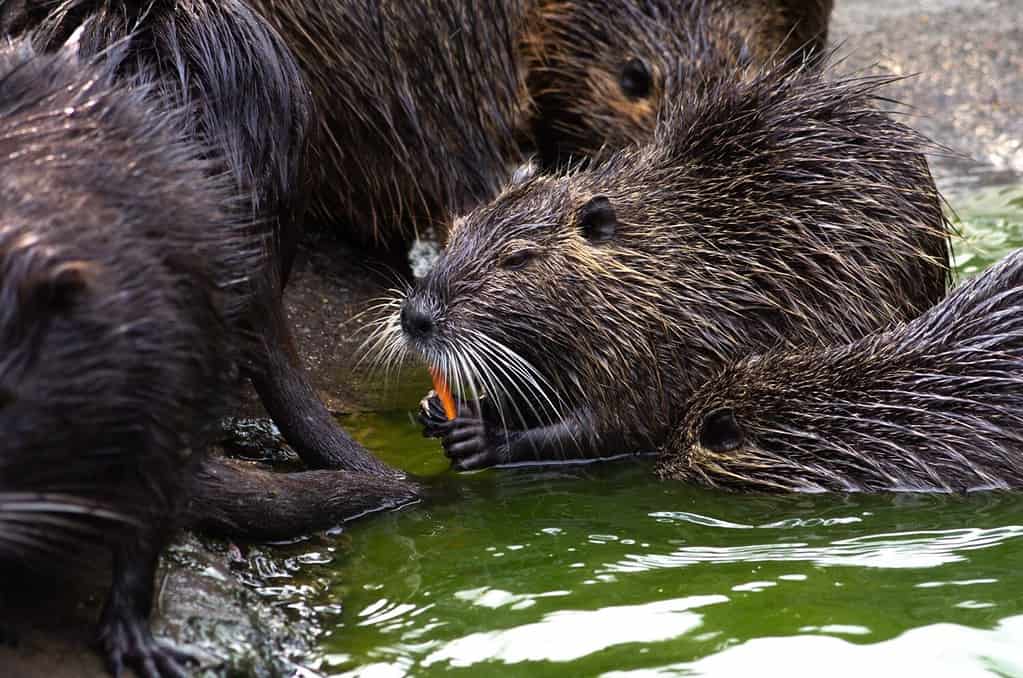
Muskrats are born hairless and blind.
©QINQIE99/Shutterstock.com
These semiaquatic rodents have partially webbed feet, which they use to build their lodges, dive, and swim. In fact, they are excellent swimmers and can paddle very quickly. They eat a third of their weight every day, which consists of insects, frogs, cattails, stalks, and roots. They inhabit the marshes, swamps, ponds, and lakes in Northern Mexico, the United States, and Canada.
Newfoundland Dogs (Canis lupus familiarise)

Newfoundlands have a sweet and calm disposition.
©TheHighestQualityImages/Shutterstock.com
This large working dog has webbed paws and a double coat, making them great swimmers. Their jobs include pulling carts, guiding the blind, and performing water rescue. They weigh between 120-180 pounds, with fur in colors of black, grey, brown, or black and white. They are known for their loyalty and gentle dispositions. A native of Newfoundland and Labrador provinces, they enjoy high-quality protein that includes fish, eggs, duck, lamb, turkey, chicken, and beef.
North American Beavers (Castor canadensis)

Beavers have orange teeth they use to chew on twigs.
©Frank Fichtmueller/Shutterstock.com
This semi-aquatic animal uses their hind webbed feet to propel them through water and their tails as rudders. A beaver can hold their breath for 15 minutes. In addition, they swim up to five miles an hour, spending much of their time in the water. They grow up to four feet in length and weigh over 60 pounds. They are the largest North American rodent, nocturnal, and live in rivers, marshes, ponds, and streams. Favorite foods include pond vegetation, leaves, and twigs.
Opossums (Didelphidea)
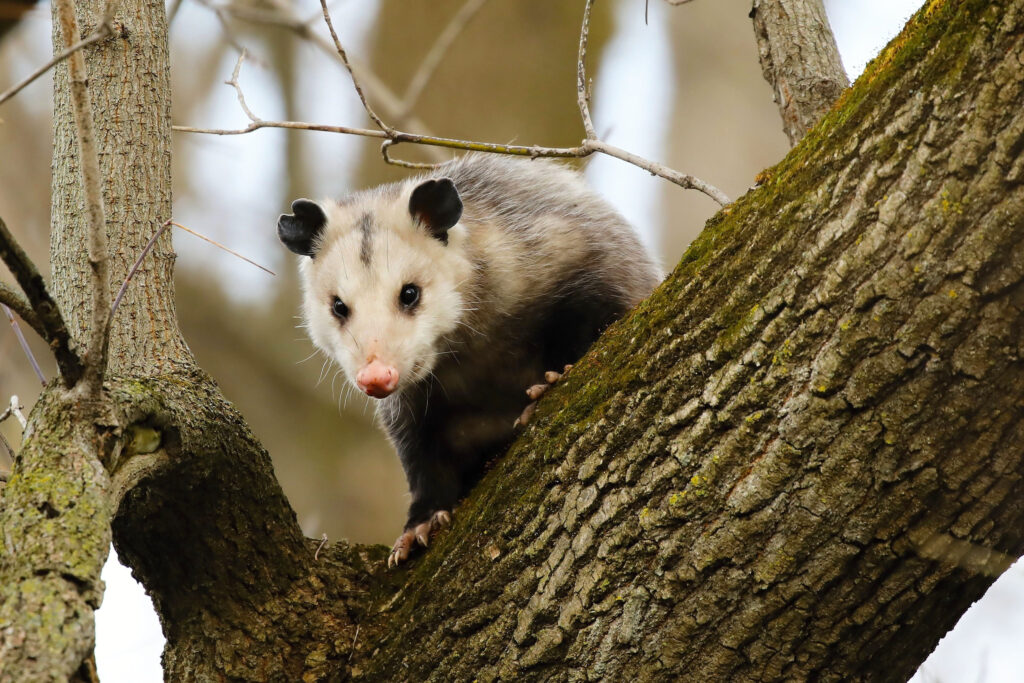
The opossum has a prehensile tail used like a hand or a fifth appendage.
©Karel Bock/Shutterstock.com
Opossums’ webbed hind feet propel them through water and help them climb trees, while their front feet enable them to grab animals. They are 10-16 inches in length and weigh from one to two pounds with waterproof coats. They live in Northern, Central, and Southern America, and feed on grains, rodents, birds, insects, and dead animals.
Platypus (Ornithorhynchus anatinus)
This unusual-looking semi-aquatic creature is one of only a few species of venomous mammals, residing in Tasmania and Australia. Specifically, only the male owns a spike on their hind foot that delivers a venom used to kill small animals and for self-defense. Their webbed feet are more prevalent on the front, which fold when on land. They have a duck bill and a beaver-like tail. Uniquely, they are the only egg-laying mammal on earth. They grow from 15-23 inches and weigh between one and five pounds. They are bottom feeders that eat larvae, worms, shrimp, crayfish, and insects.
Polar Bears (Ursus maritimus)
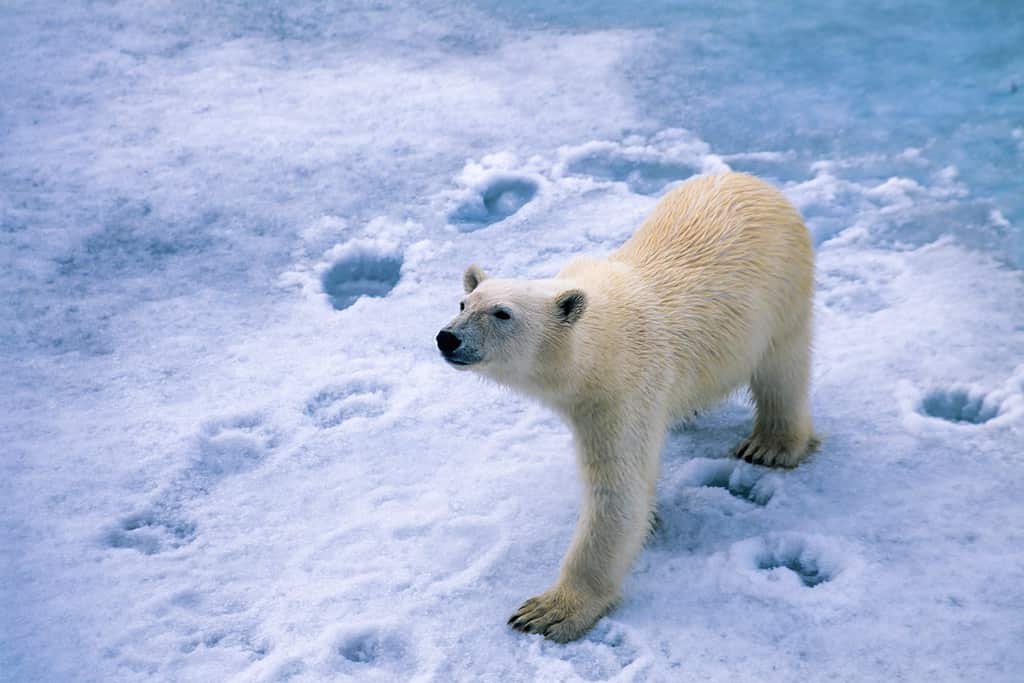
Although
polar bears
have white fur, their skin is black.
©Lasse Johansson/Shutterstock.com
Polar bear’s partially webbed feet make them skilled swimmers. They use their front paws for padding and their back paws for steering, and reach speeds up to six miles per hour! These semi-aquatic bears are the largest land carnivores, being related to the brown bear. They live in coastal areas throughout the Arctic. Their webbed feet help them to walk on ice, and they spend much of their time hunting seals but also enjoy beluga, narwhal, and walrus.
Portuguese Water Dogs (Canis lupus familiarise)

Portuguese Water Dogs herd fish into fishermen’s nets and retrieve lost tackle or broken nets.
©Lynda McFaul/Shutterstock.com
Bred to be fishermen’s companions, their webbed feet enable them to be great swimmers. They are native to Portugal and possess high energy. Leans, proteins, and fish are their favorite foods.
Sea Otters (Enhydra lutris)
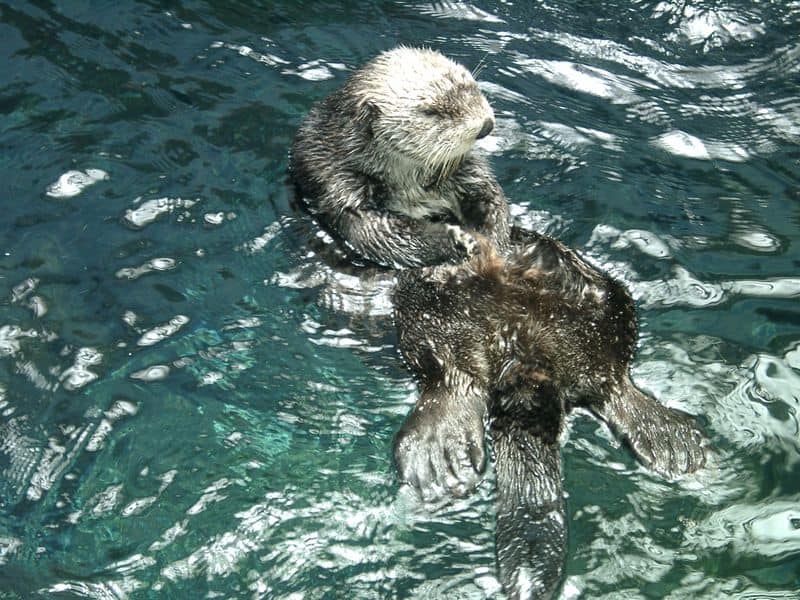
The
sea otter
is the only marine mammal that catches fish with their forepaws and not their mouth.
A member of the weasel family, the sea otter lives in coastal waters of the Pacific Ocean in Asia and North America. They grow to about 4 feet in length and weigh between 31-99 pounds, depending on gender. Their webbed hind feet and powerful tails help propel them through the water. They have water-repellent fur that keeps them warm and dry as well as keeping water out of their nostrils and ears. In fact, they prefer to spend their time underwater and can hold their breath for about eight minutes. They like to feed on crabs, reptiles, crayfish, birds, and fish. Additionally, their river cousin the European Otter ((Lutra lutra) lives in freshwaters, such as streams, lakes, ponds, and rivers in Europe.
Siberian Huskies (Canis lupus familiarise)
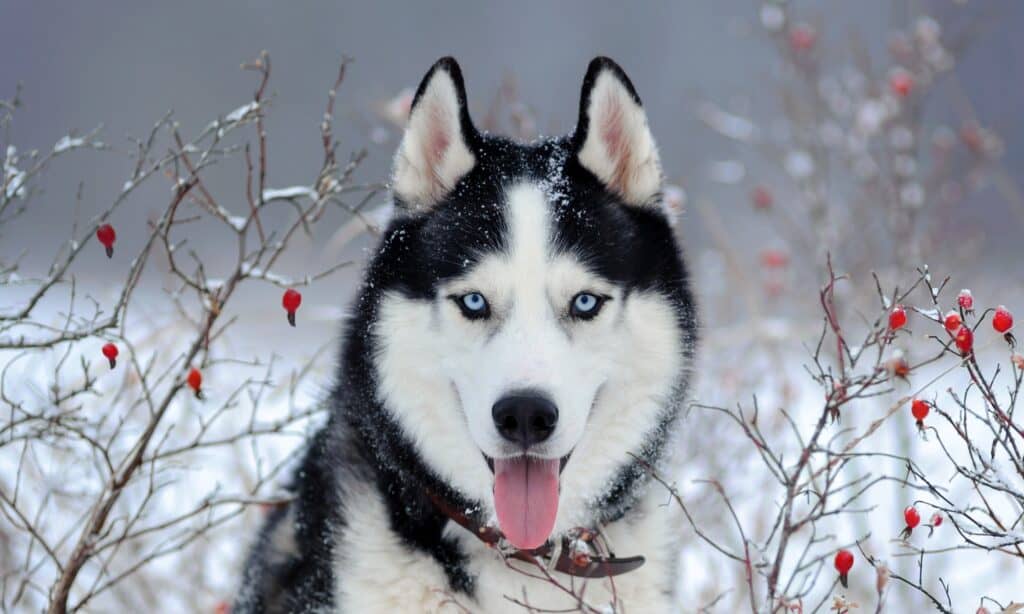
The
Siberian
Husky is traced to the Chukchi people, an ancient tribe from northern Siberia.
©iStock.com/format35
This medium-sized working dog uses their webbed feet to aid them in walking and running on ice and snow, which act like snowshoes! They have a double coat to repel water and keep them warm. They are originally from Northeast Asia and used as sled dogs due to their high endurance and ability to survive in the harsh Siberian Arctic. A balanced diet is important for this hard-working breed, including animal and plant proteins, nuts, eggs, grains, vegetables, and fruits.
Sphynx Cats (Felis catus)

The Sphynx is a very social and dog-like cat.
©Alexander Piragis/Shutterstock.com
A result of a genetic mutation that occurred in 1966, the sphynx originates from Canada. While all domestic cats have partially webbed feet, this species specifically owns extra-long, hairless big toes that make their webbed feet the most noticeable. The webbing helps them navigate muddy, wet surfaces without sinking, and to propel themselves in water, which they dislike. In addition, some have fine hair, but they all possess large ears and muscular bodies that get to about 8-10 inches tall.
| Animals with Webbed Feet | Where they Live |
|---|---|
| Albatross (Phoebastria irrorate) | New Zealand, Australia, Antarctica, and South America |
| Antarctic Petrels (Thalassoica Antarctica) | Antarctica, particularly the Weddell and Ross Seas |
| Avocets (Recurvirostra) | South and North America, Europe, and Asia |
| Blue-Footed Boobies (Sula nebouxii) | Tropical areas of the Pacific Ocean |
| Cormorants (Phalacrocoracidae) | Central Pacific Islands |
| Crab Plovers (Dromas ardeola) | Coasts and islands of the Indian Ocean |
| Ducks (Anatidae) | Rivers, wetlands, lakes, and ponds worldwide |
| Flamingos (Phoenicopterus ruber) | Iceland, Greenland, the Northern United States, and Canada |
| Geese (Anatidae) | North America, Europe, and Asia |
| Loons (Gavia) | Iceland, Greenland, Northern United States, and Canada |
| Pelicans (Pelecanus) | Pacific, Atlantic, and Gulf coasts |
| Penguins (Spheniscidae) | Australia, South America, New Zealand, Africa, and Antarctica |
| Puffins (Fratercula) | North Pacific and the North Atlantic |
| Seagulls (Larus dominicanus) | Coastal areas including South and North America, Europe, the Caribbean, Australia, and Antarctica |
| Trumpeter Swans (Cygnus buccinator) | North America |
| Alligators (Alligator mississippiensis) | Southeastern United States |
| Crocodiles (Crocodylidae) | Sahara, Madagascar, and Southeast Asia |
| Iguanas (Iguana iguana) | Caribbean, South and Central America, and Mexico |
| Axolotls (Ambystoma mexicanum) | Mexico |
| American Bullfrogs (Lithobates catesbeiana) | North America |
| Common Frogs (Rana temporaria) | Britain |
| Natterjack Toads (Epidalea calamita) | Ireland, Britain |
| Turtles (Testudines) | South Asia and Southeastern North America |
| Capybaras (Hydrochoerus hydrochaeris) | Central and South America |
| Eastern Moles (Scopus aquaticus) | Mexico, the United States, and Canada |
| Fishing Cats (Prionailurus viverrinus) | South and Southeast Asia |
| Hose’s Palm Civets (Diplogale hosei) | Brunei and Borneo |
| Minks (Neovison vison) | North America, Canada, and Newfoundland |
| Muskrats (Ondatra zibethicus) | Northern Mexico, the United States, and Canada |
| Newfoundland Dogs (Canis lupus familiaris) | Newfoundland and Labrador |
| North American Beavers (Castor canadensis) | North America |
| Opossums (Didelphidea) | Northern, Central, and Southern America |
| Platypus (Ornithorhynchus anatinus) | Tasmania and Australia |
| Polar Bears (Ursus maritimus) | Artic |
| Portuguese Water Dogs (Canis lupus familiaris) | Portugal |
| Sea Otters (Enhydra lutris) | Pacific Ocean in Asia and North America |
| Siberian Huskies (Canis lupus familiaris) | Northeast Asia |
| Sphynx Cats (Felis catus) | Canada |
The photo featured at the top of this post is © Fcb981 / CC BY-SA 3.0, Wikimedia Commons – License / Original
Thank you for reading! Have some feedback for us? Contact the AZ Animals editorial team.



